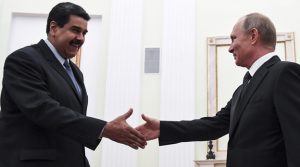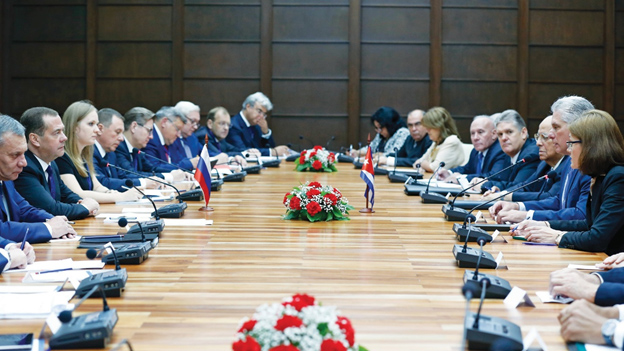The Russian Federation considers the Latin American (LATAM) region one of the main areas of its ongoing global outreach. Despite a relatively light footprint in terms of manpower and materiel, Russia has managed to maintain and strengthen its military-security relationship with three key states: Venezuela, Cuba, and Nicaragua. Moscow is also seeking to expand its influence beyond these states by engaging in political, economic, or military initiatives with a growing list of LATAM nations. Yet the Russian security establishment is concerned with the loss of Russian influence, given its investments in Venezuela, and the role of U.S. allies in a likely conflict.
In order to understand how Russia sees its involvement in the region, it is useful to read official statements via the Russian Ministry of Foreign Affairs (MFA) or Ministry of Defense’s (MOD) official websites. Such statements may vary from criticizing Colombia for aligning with the United States against Caracas, to calls for a broader dialogue in post-Morales Bolivia, to hopeful and encouraging language about Brazil as part of the larger BRICS (Brazil, Russia, India, China, and South Africa) global initiative. Beyond such obvious sources are outlets that often publish the opinions of Russian military and civilian officials of various standing. Given how much attention the Russian security establishment is paying to the ongoing crisis in Venezuela and the actions of Venezuela’s neighbors, public op-eds and opinions from active and retired Russian military and government personnel are a window into sometimes opaque Russian foreign policy debates. These debates include questions on the Russian military posture, regional order of battle, and larger geopolitical overview of Russian interests in Latin America.
Open source

There are several open source publications where Russian military officials, academics, and senior researchers publish on defense, security, and political topics. The Military-Industrial Courier (Voenno-Promyshlennyi Kur’er, VPK, in Russian) and Independent Military Review (Nezavisimoe Voennoe Obozrenie, NVO, in Russian) are of particular interest. For example, VPK runs regular op-eds and articles by Russian Defense Minister Sergey Shoigu, and Chief of the General Staff General Valery Gerasimov. These publications are tailored to the narrow domestic and international audience specifically interested in Russian military and security matters. Many students in Russian military academies and institutions — often with a rank of colonel or lieutenant colonel, either active or retired — also publish there. Once public, such articles raise the question: To what extent is the content a reflection of official MOD or MFA policy, instead of just that of the author?
When it comes to LATAM, article language varies, while at the same time offering an opportunity to discern whether content reflects current military thought and debate. In August 2019, NVO ran an article with opinions from four current and retired senior Russian officials on using LATAM as a countermeasure to the United States leaving the Intermediate-Range Nuclear Forces (INF) Treaty. Signed in 1987, this treaty led to the elimination of thousands of U.S. and Soviet nuclear and conventional ground-launched ballistic and cruise missiles. In the article, one Russian military commentator suggested that in the context of a possible termination of nuclear disarmament treaties, Moscow should increase its presence near the borders of the United States, and should deploy strategic aviation on one of the Venezuelan islands in the Caribbean Sea.
Another commentator, a senior Russian government official, suggested that Moscow should negotiate with Venezuela for placements of missiles, alluding to the 1962 Caribbean Crisis, which “allowed Americans to cool off for a long time. If a [missile] system were to be located in Venezuela, then the U.S. would behave more cautiously.” A different military commentator said that a permanent Russian naval presence off the coast of the United States would be a powerful message, while his more senior-ranked military counterpart suggested that an answer to U.S. actions should be Russia’s Kalibr missiles placed with Russian allies and assets across LATAM. Kalibr refers to the family of surface ship and submarine-launched airborne cruise missiles, with a range of up to 1,500 miles. The Russian Navy has started to use Kalibr missiles across its surface and submarine fleets.
For the record, these were not official MOD or MFA statements. At the same time, the proposals in the article targeted not just the United States, but potentially sent a strong signal to Colombia and Brazil, two nations with large militaries, and whose governments are currently taking an anti-Maduro position. There would be no defense in Colombia and Brazil against Russian long-range missiles stationed in Venezuela, short of an expensive arms race. Such a course of events may run counter to Russia’s recent official efforts to engage Brazil and Colombia via mil-to-mil and economic proposals. Yet Russia’s own announcements in February 2020 that it will increase military-industrial cooperation with Caracas nonetheless keep the possibility of regional conflict open.
Russian weapons
When Russian civilian high-profile experts voice their opinion in military publications, the content may offer similar viewpoints to military officers mentioned in an earlier VPK analysis. In a VPK article from April 2019, Aleksandr Hramchihin, deputy director of the Russian Institute for Political and Military Analysis (PIR, in Russian), discussed potential combat operations between Venezuela and its pro-U.S. neighbors: Brazil, Colombia, and Ecuador. Hramchihin is one of the most recognized security experts in Russia, and has a large body of work related to Russian conduct of war.
According to Hramchihin, the Venezuelan army is unquestionably the strongest in South America due to mass purchases of Russian weapons. The Ecuadorean Armed Forces are “small and rather archaic,” and the Colombian army, “with its enormous personnel, is completely unprepared for ‘classical’ [conventional] war.” Hramchihin’s critique of the Colombian military, given its close cooperation with the U.S. Department of Defense’s initiatives, includes the lack of main battle tanks and light tanks — a uniquely Russian take on the country’s military strength, given Moscow’s own long history of tank warfare. He does recognize the unique LATAM environment: “Of course, most of the Colombian border with both Venezuela and Ecuador is a jungle — tanks are useless there. But in coastal areas, where the majority of the population of all [three] countries lives, it is quite possible to use heavy equipment like tanks.” Hramchihin notes that the Brazilian Armed Forces are larger than Venezuelan forces, “although much more archaic — they have several hundred tanks, but they are all European and American ‘scrap metal.’”
In his article, Hramchihin’s attitude toward Colombian, Ecuadorean, and Brazilian militaries is generally dismissive mostly due to what he sees as older military equipment in service when compared to Venezuela. For example, he notes that while the Brazilian Air Force has more combat aircraft, “[planes] are much older and have no chance of breaking through Venezuela’s air defense,” for pro-Russian Venezuela, there is a threat from the south, as the new Brazilian government has become an active opponent of the Maduro regime. At sea, Brazil’s superiority “seems overwhelming, but it is hardly significant.” He notes that “the U.S. Air Force and U.S. Naval aviation will destroy the Venezuelan army from the air, and Colombians and Brazilians will be assigned the role of ground assault troops.” In this version of conventional combat, Caracas would not last long, “but the guerrilla war in the jungle could drag on for many years.”
Hramchihin’s failure to properly appreciate the quality of Colombian, Ecuadorean, and Brazilian militaries may reflect a wider view held across the Russian security establishment, which sees U.S. potential involvement in regional combat as utterly decisive, irrespective of actual strength of regional militaries. But it also may ignore major strides in professionalism made by Colombian and Brazilian militaries in training and equipment made over the past several decades. Despite the lack of certain weapons that some Russia-based analysts may consider decisive (such as tanks), Venezuelan military is also dealing with ongoing anti-government sentiment in the country. On the other hand, the militaries of Colombia and Brazil have a good relationship with their populations and governments, which may prove decisive should conflict break out.
Strategic bombers and naval vessel visits
What to make of these statements? On the one hand, these publications may have aired some long-held viewpoints about military capabilities of U.S. allies in the region. On the other hand, do such statements from active military personnel broadcast the official Russian policy in LATAM? There have already been demonstrative Russian actions in the region, such as strategic bombers and naval vessel visits. At this point, Russian footprint in friendly states such as Cuba, Venezuela, and Nicaragua is still relatively small and contained to select personnel. An opinion or an op-ed in a respected publication could be just that — or it could be an actual public message directed at a wider audience in the region.
But why should Russia be involved in the LATAM region in the first place? While pro-Russian states may not stand an actual chance against the United States and its allies in combat, maintaining ties to Moscow’s key partners is essential to prevent a “domino theory” of geopolitical losses in LATAM, and elsewhere. In a November 2019 VPK article, a Russian foreign policy specialist may have reflected a relatively widespread opinion in the Russian security and foreign policy establishment.
The author asked what would happen after Bolivia’s Evo Morales fled into exile, and what country would be “next in line for a [post-Bolivian, ‘U.S.-instigated’] coup.” According to the author, Washington would strike Venezuela, where, following the example of Bolivia, the people, with support from the military, would overthrow Nicolás Maduro. Nicaragua would come next, then Cuba, which would be left without Venezuelan oil. The author repeats a now typical Russian viewpoint that the “coup technology” (better known as the “color revolutions” concept), used by the United States in Venezuela and Bolivia, can also be applied in Russia. The author notes that the main issue in Bolivia and Venezuela is not “color revolutions.” “It is an [actual] coup d’état, organized with an agreement with elite groups. There is no antidote to it today.” His message may also be potentially directed at other nations across LATAM that are not openly aligned with Moscow, hinting at political change should countries end up out of step with Washington’s policies.
Such articles in respected Russian publications may reflect a wider viewpoint, or may be a unique reflection of one individual. Regardless, the Russian defense and security establishment continues to debate its role in the Latin American region, as it increases its involvement in Venezuela and elsewhere. While some viewpoints in Russian military magazines may be relegated to the sidelines of mainstream thought, other voices may in fact reflect the opinion of actual decision makers, directed at nations across LATAM that have a major security and military regional role. Such debates deserve attention, given the rapidly evolving situation with respect to the Russian presence in the region.








